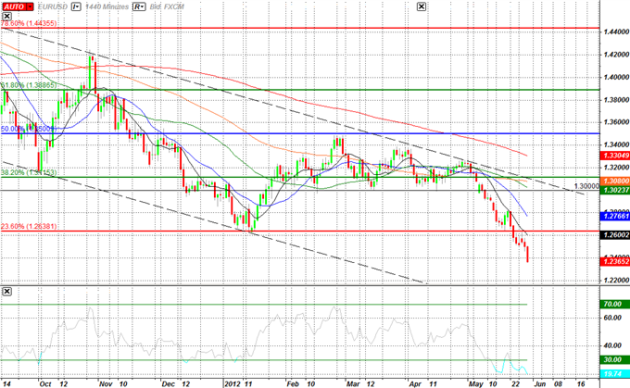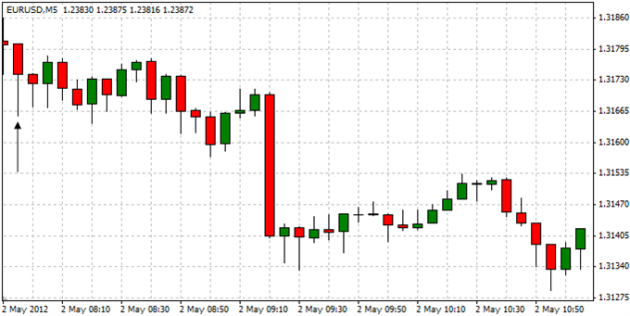TOKYO (Reuters) - Asian shares, the euro and oil prices fell on Thursday as surging borrowing costs in troubled Spainheightened fears that more countries in the euro zone will be hit hard by the region's debt crisis.
Japan's Nikkei average (.N225) (.T) slid 2 percent while MSCI's broadest index of Asia-Pacific shares outside Japan <.MIAPJ0000PUS> looked set to revisit its 2012 low with a decline of 0.8 percent.
The euro fell in early Thursday trade to a 23-month low of $1.2361 and a 4-1/2 month low against the safe-haven yen below 97.70.
"There is no exit in sight currently for the euro to get out of this downtrend because there is no shortage of negative news," saidHisamitsu Hara, chief FX manager at Bank of Tokyo-Mitsubishi UFJ.
"Problems in Spain, a large euro zone economy, heighten fears while the risk of Greece leaving the euro bloc raises contagion concerns. The euro remains depressed, with players cautiously testing the downside".
Hara added that the euro could weaken until support at the$1.19 level. The euro dipped below $1.19 in June 2010.
A caution by Spain's central banker that Madrid will miss deficit targets this year pushed Spanish 10-year yields above 6.7 percent, close to 7 percent, a level seen as unsustainable and which could push Spain to seek a bailout.
The cost of insuring against a Spanish default scaled a record high near 600 basis points while Italy, which is also struggling with huge public debt, saw its 10-year yields top 6 percent for the first time since January.
Yields on all German bond maturities hit record lows on Wednesday, pushing the premium investors demand to hold Spanish debt over German debt to its highest since the launch of the euro at around 543 basis points.
Those developments led to declines of more than 1 percent for both U.S. and European stocks. Spain's stock market hit a nine-year low.
As risk aversion gripped financial markets broadly, strong bids for safe-haven assets sent 10-year U.S. Treasury yields down to their lowest in at least 60 years at 1.620 percent on Wednesday. The yield on five-year Japanese government bonds fell to 0.20 percent, its lowest since October 2010.
The dollar index (.DXY), measured against a basket of major currencies, extended its rally to reach its highest level since September 2010 above 83.1 on Thursday. The yen rose to a 3-1/2 month high against the dollar at 78.86.
Some analysts said the dollar index could be in for a sustained period of dollar strength for the next couple of years.
The strong dollar and intensifying risk aversion sent the Thomson Reuters-Jefferies CRB index (.CRB), a global benchmark for commodities, tumbling 1.7 percent on Wednesday to its lowest levels since September 2010.
Oil prices fell to multi-month lows on Wednesday and looked set to post their biggest monthly declines since October 2008, a month after the collapse of Lehman Brothers.
U.S. crude futures were down 0.3 percent at $87.60 a barrel on Thursday, after slumping $2.94 to settle at $87.82, the lowest settlement since October 21, 2011.
Brent crude fell 0.3 percent to $103.19 a barrel on Thursday after falling more than $3 to settle at $103.47 a barrel, the lowest settlement since December 16.
The European Commission threw Spain two potential lifelines, offering more time to reduce its budget deficit and offering direct aid from a euro-zone rescue fund to recapitalize distressed banks.
But any relief from the news was quickly offset by the latest Greece polls showing parties for and against a bailout neck-and-neck or very close to each another ahead of a June 17 election that may decide whether Greece remains in the euro.
Asian credit markets were weaker, with the spread on the iTraxx Asia ex-Japan investment-grade index widening by 5 basis points early on Thursday.






